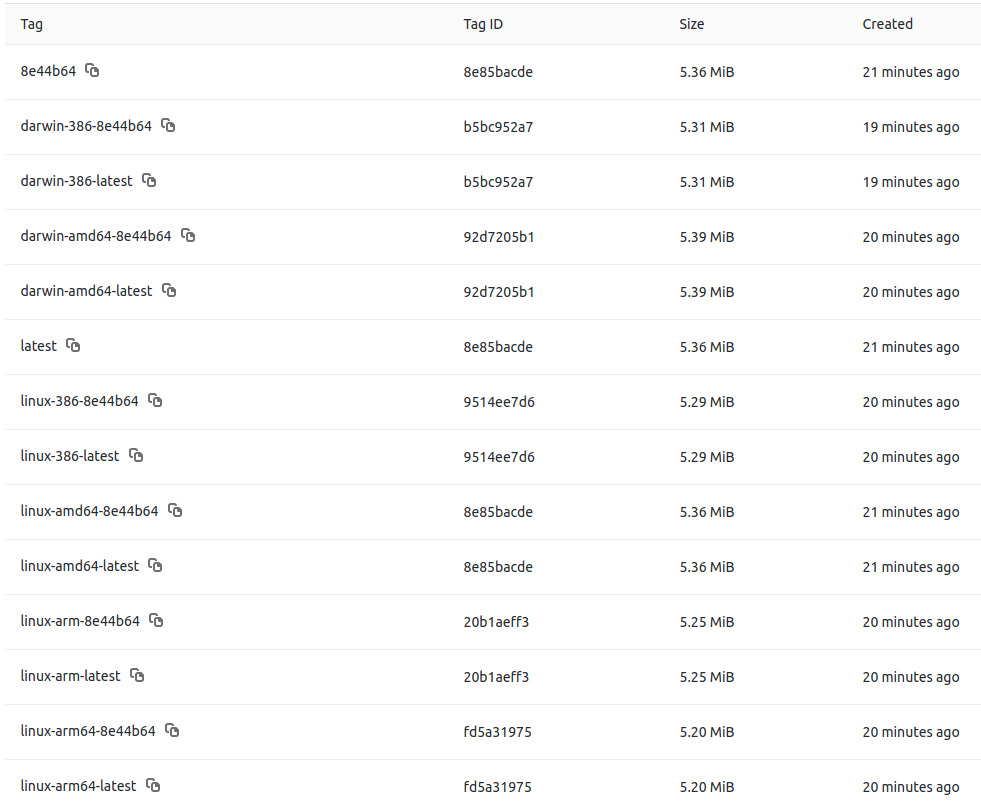The main purpose of the repository is automated provisioning of Golang Docker containers for multiple CPU architectures. The included app is a stripped down version of our reverse proxy to a maintenance page hosted in AWS S3 bucket fronted by CloudFront CDN. By using a S3 bucket we maintain a centralized repository for our maintenance pages that is globally accessible and easy to maintain.
The container/app listens on TCP port 8989 by default but it can be overwritten during runtime via environment variable and/or command line flag. Same applies to the target URL which is by default set to http://my-cdn.s3-website.my-region.amazonaws.com/maintenance/myapp/. For example:
$ go run main.go
2019/07/22 11:12:21 forwarding to -> http://my-cdn.s3-website.my-region.amazonaws.com
2019/07/22 11:12:21 Starting the service listening on port :8989 ...
$ PORT=8084 go run main.go
2019/07/22 11:12:21 forwarding to -> http://my-cdn.s3-website.my-region.amazonaws.com
2019/07/22 11:12:21 Starting the service listening on port :8084 ...
$ go run main.go -port=8081 -proxy_target_url=http://google.com/
2019/07/22 10:55:38 forwarding to -> http://google.com
2019/07/22 10:55:38 Starting the service listening on port :8081 ...If both set the command line flag will have priority:
$ PORT=8084 go run main.go -port=8090
2018/06/14 10:13:30 Starting the service listening on port :8090 ...The container has liveness /healthz and readiness /readyz end points too for Kubernetes probes. It also simulates 1 second load time to make the readiness check more realistic as shown below.
$ go run main.go
2019/07/22 11:12:21 forwarding to -> http://my-cdn.s3-website.my-region.amazonaws.com
2019/07/22 11:12:21 Starting the service listening on port :8989 ...
2019/07/22 11:12:21 Ready NOK
2019/07/22 11:12:22 Ready OKThe motivation is to provide Docker images for use with the AWS EC2 A1 Instances that deliver significant cost savings and are ideally suited for scale-out and Arm-based workloads that are supported by the extensive Arm ecosystem. A1 instances are the first EC2 instances powered by AWS Graviton Processors that feature 64-bit Arm Neoverse cores and custom silicon designed by AWS.
At the end of the GitLab pipeline we end up with multiple images as shown below:
We utilize the Makefile provided with the project. To build and push docker images for multiple architectures we simply run:
$ make dockerTo run through the full stack of linting and testing the binary before we build the Docker images we run (needs Go properly installed and setup if executing this locally):
$ make allBy deafult images are built for the following architectures: linux/amd64, linux/386, linux/arm, linux/arm64, darwin/amd64 and darwin/386. This can be changed via the PLATFORMS variable in runtime, for example:
$ PLATFORMS="linux/amd64 linux/arm64"Execute make help to find out the available make targets. The DOCKER_REGISTRY and DOCKER_REPOSITORY are some of the environment variables we can edit in runtime if necessary:
$ DOCKER_REGISTRY=<value> DOCKER_REPOSITORY=<value> make all Or strictly passing them as make variables which will also work:
$ make DOCKER_REGISTRY=<value> DOCKER_REPOSITORY=<value> all Check the Makefile for complete list of variables.
After running make docker or make all as mentioned above, we also get a Docker Manifest created that holds a description of all the images
$ docker manifest inspect $DOCKER_REGISTRY/projects/go-proxy-multiarch:f5b1c7f
{
"schemaVersion": 2,
"mediaType": "application/vnd.docker.distribution.manifest.list.v2+json",
"manifests": [
{
"mediaType": "application/vnd.docker.distribution.manifest.v2+json",
"size": 1157,
"digest": "sha256:8b452e3a80d985693ca2419cae8bc3221434834206186ea690e5e3c7487e3e68",
"platform": {
"architecture": "386",
"os": "darwin"
}
},
{
"mediaType": "application/vnd.docker.distribution.manifest.v2+json",
"size": 1157,
"digest": "sha256:700c7d1677947b3d1349f2679add456ffd0fbddeb35ad23714667cfdc4b59a9b",
"platform": {
"architecture": "amd64",
"os": "darwin"
}
},
{
"mediaType": "application/vnd.docker.distribution.manifest.v2+json",
"size": 1157,
"digest": "sha256:e8a6051bc7457afbd76c128f49a4f662c66ca6156920bb276f0b05e0b2d57b27",
"platform": {
"architecture": "386",
"os": "linux"
}
},
{
"mediaType": "application/vnd.docker.distribution.manifest.v2+json",
"size": 1157,
"digest": "sha256:7816c936340293153146ec860a1ce02ecbd744ea1dbf7978bb035961677304f3",
"platform": {
"architecture": "amd64",
"os": "linux"
}
},
{
"mediaType": "application/vnd.docker.distribution.manifest.v2+json",
"size": 1157,
"digest": "sha256:5ca45598cd7bde4d72845f14acc2baa93dadb693e9dfa8b2c11835f37019e329",
"platform": {
"architecture": "arm",
"os": "linux"
}
},
{
"mediaType": "application/vnd.docker.distribution.manifest.v2+json",
"size": 1157,
"digest": "sha256:6fb06edd39392a2fa11e60ff01319dedda79e7125b7cb0da34e5c3139235d767",
"platform": {
"architecture": "arm64",
"os": "linux"
}
}
]
}
$ docker manifest push $DOCKER_REGISTRY/projects/go-proxy-multiarch:f5b1c7f
sha256:930ee604c2e3c38b33a89b9b3f4a1b9ecb90c74fa3512c3810a83990bea16524It uses docker manifest command which is experimental and needs to be enabled by editing the ~/.docker/config.json file and setting experimental to enabled for the user running the Docker client. The same parameter but with value true needs to be enabled for the Docker daemon too in the /etc/docker/daemon.json file.
By providing Docker Manifest to the registry we make it possible to always reference our image as $DOCKER_REGISTRY/projects/go-proxy-multiarch:[f5b1c7f | latest] no matter the architecture we are running on and the docker client will pull down the correct image for us.
This is an example of pulling the go-proxy-multiarch:latest on a linux amd64 machine:
$ docker pull $DOCKER_REGISTRY/projects/go-proxy-multiarch:latest
latest: Pulling from projects/go-proxy-multiarch
050382585609: Pull complete
d4455207f581: Pull complete
bf48981c7f63: Pull complete
ab951a48b278: Pull complete
Digest: sha256:7816c936340293153146ec860a1ce02ecbd744ea1dbf7978bb035961677304f3
Status: Downloaded newer image for $DOCKER_REGISTRY/projects/go-proxy-multiarch:latest
$ docker inspect $DOCKER_REGISTRY/projects/go-proxy-multiarch:latest
[
{
"Id": "sha256:97c4a2e60c7dfb0baa2340b11863ed11478d787c341525dcc756b7b9910951d4",
"RepoTags": [
"$DOCKER_REGISTRY/projects/go-proxy-multiarch:latest"
],
[...]
"DockerVersion": "18.03.0-ce",
"Author": "",
"Config": {
[...]
},
"Architecture": "amd64",
"Os": "linux",
"Size": 13106648,
"VirtualSize": 13106648,
"GraphDriver": {
"Data": null,
"Name": "aufs"
},
}
]where we can see Docker automatically choosing the right image version (notice the Digest hash for the image being same as in the Manifest above) that matches the local architecture thanks to the Docker Manifest. Lets give the image a test run:
$ docker run -dit --rm -p 8989:8989 --name go-proxy-multiarch $DOCKER_REGISTRY/projects/go-proxy-multiarch:latest
bb12d5acb6a740e738c6753a4eeb8ea6742c4756f98e373d82cad3f16639c262
$ curl -sSNIL http://127.0.0.1:8989/
HTTP/1.1 200 OK
Content-Length: 10656
Content-Type: text/html
Date: Tue, 23 Jul 2019 02:20:06 GMT
Etag: "09eebd280f81db787eb9d80e8842ed59"
Last-Modified: Thu, 27 Jun 2019 00:54:48 GMT
Server: AmazonS3
X-Amz-Id-2: 8gnTxlOqufGNUxhgSEI+zV6A3AxE97WXWcm/MVPuvw+TZg1TcHB4sLJ+p+qxsWsUvJuE7bapkCw=
X-Amz-Request-Id: 4A54B78DCABE92B6
X-Amz-Version-Id: EhIK9BL0OAAsInTq6I6GMRMvyvkB3BSf
X-Proxy: localhost
$and all is working as expected.
The provided .gitlab-cy.yml is used in our GitLab CI/CD pipeline. It runs through dep, test and build stages. The build stage is pretty simple:
build:
stage: build
dependencies:
- dep
image: $DOCKER_IMAGE
variables:
#DOCKER_CLI_EXPERIMENTAL: "enabled" # not needed, enabled in the image
#DOCKER_TAG: $CI_JOB_ID # Optional: override the image tag in the Makefile (commit hash by default)
services:
- $DOCKER_DIND_IMAGE
before_script:
- apk --no-cache add --update build-base bash
- docker version
- docker login -u gitlab-ci-token -p $CI_JOB_TOKEN $CI_REGISTRY
script:
- make docker
It uses the builder igoratencompass/docker-dind-make and DinD igoratencompass/docker-dind:18.09.7 Alpine based Docker images with experimental feature enabled for docker manifest command to work. The builder image has bash and build-base installed to make compiling possible.
